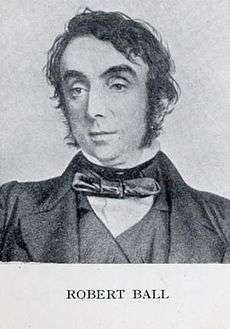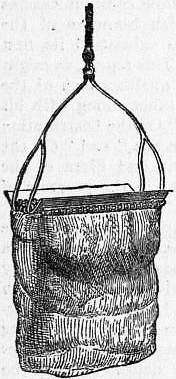Robert Ball (naturalist)

Robert Ball (1802-1857) was an Irish naturalist.
Life
He was born at Queenstown (today known as Cobh), County Cork. The Ball family lived in Youghal, County Cork. Robert had a brother, Bent, and two sisters Anne, a well-known phycologist, and Mary, an entomologist. The family was Protestant and "involved in trade".
After a career in the civil service he became Director of the Dublin University Museum in 1844. He was a Member of the Royal Irish Academy and President of the Geological Society of Ireland
Dublin University conferred on him the degree of LL.D. He became Secretary of the newly founded Queen's University of Ireland in 1851, and was a Fellow of the Royal Society.[1]
Family
Robert Ball was the father of the Astronomer Royal Sir Robert Stawell Ball, Valentine Ball (1843-1895) C.B., BA,MA, LL.D., F.R.S. a geologist and naturalist, Professor at Trinity College Dublin, and Sir Charles Bent Ball (1851–1916) BA, MB, M.Ch., FRCSI, a surgeon and botanist.[1]
Works
- On the museum
- (1846) First Report on the Progress of the Dublin University Museum, January 1846. Dublin.
- (1847) Second Report on the Progress of the Dublin University Museum, June 1847. Dublin.
- (1848) The Dublin University Museum, December, 1848. Dublin.
- (1853) Evidence. In Dublin University Commission, Report of Her Majesty's Commissioners appointed to inquire into the state, discipline, studies and revenues of the University of Dublin and Trinity College. Dublin. 153-169.
- Scientific
- 1841. On a species of Loligo, found on the shore of Dublin Bay. Proceedings of the Royal Irish Academy, 1 (19). 362-364.
- 1842 Notes of the acetabuliferous Cephalopoda of Ireland, including two species of Rossiae. Proceedings of the Royal Irish Academy 2: 192-194.

Ball's dredge
About 1838 Robert Ball devised a dredge net to collect marine organisms. It was used all over the world, and was so apt for its purpose that it was little modified later. It is known as Ball's dredge or more generally simply "the dredge". Ball's dredge consists of a rectangular net attached to a rectangular frame much longer than high, and furnished with rods stretching from the four corners to meet at a point where they are attached to the dredge rope. It differed from the dredge net devised by Otto Friedrich Müller in the slit-like shape of the opening, which prevents much of the " washing out " suffered by the earlier pattern, and in the edges. The long edges only are fashioned as scrapers, being wider and heavier than Muller's, especially in later dredges. The short edges are of round iron bar.
Death
Ball died as a result of a ruptured aorta on 30 March 1857.[2]
References
- 1 2 Robert Ball LLD, FRS - Biography Botanic Gardens Dublin
- ↑ "Obituary notice.—Dr. Robert Ball of Dublin". Annals and Magazine of Natural History Series 2. 19 (113): 432. 1857. doi:10.1080/00222935708693963. Retrieved 19 January 2016.
Further reading
- Jackson, P. N. W. 2009. Robert Ball (1802–1857): naturalist. Ir. Nat. J. 30: 15 - 18.
External links
- Webb, Alfred (1878). "
 Ball, Robert". A Compendium of Irish Biography. Dublin: M. H. Gill & son. Wikisource
Ball, Robert". A Compendium of Irish Biography. Dublin: M. H. Gill & son. Wikisource - NAHSTE
- Darwin Project
- Obituary
- Deep-Sea-Dredging
- Attribution
![]() This article incorporates text from a publication now in the public domain: "Ball, Robert". Dictionary of National Biography. London: Smith, Elder & Co. 1885–1900.
This article incorporates text from a publication now in the public domain: "Ball, Robert". Dictionary of National Biography. London: Smith, Elder & Co. 1885–1900.